Hoosiers without Banks: Differences by Race, Income and Metro Area
While most Hoosiers have checking or savings accounts and use banks and credit unions for typical financial services, almost a quarter of households do not have a member with a bank account or still rely on alternative financial establishments for check-cashing services and loans.
The fact that many Americans—particularly minorities—continue to use a host of alternative financial services including store-front establishments and pawn shops is a cause of concern to many government officials as well as consumer protection advocates.
This article looks at the “unbanked” and “underbanked” populations in Indiana, paying attention to differences based on race/ethnicity and income. This report follows the nationwide findings presented in the FDIC’s National Survey of Unbanked and Underbanked Households by providing a more detailed analysis of Indiana’s metropolitan regions. Data come from the special January 2009 supplement of the U.S. Census Bureau’s Current Population Survey (CPS) commissioned by the FDIC.1
Unbanked and Underbanked Households
Unbanked households do not have any members who have a checking or savings account. Underbanked households, on the other hand, have a member with a checking or savings account but still use institutions other than banks for their important financial transactions. Such transactions include receiving a refund anticipation loan within the past five years or the use of at least one of the following over the past two years: money orders, check-cashing services, payday loans, rent-to-own agreements or pawn shop transactions.
The FDIC survey estimated that more than 30 million (over a quarter of U.S. households) were either unbanked (9.1 million, or 7.7 percent) or underbanked (21.3 million, 17.9 percent). The percentage of Indiana households with low reliance on banking services was comparable to national statistics with 180,000 households unbanked (7.4 percent) and another 410,000 (16.8 percent) that were underbanked (see Figure 1).
Figure 1: Unbanked and Underbanked Households in Indiana and the United States, 2009
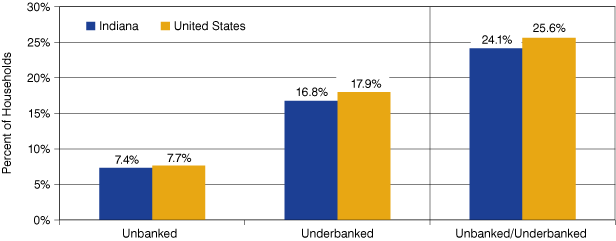
Source: IBRC, using data from the FDIC National Survey of Unbanked and Underbanked Households, 2009
Nationally, 66 percent of unbanked households used non-bank institutions for money order, check-cashing, rent-to-own, payday loan and pawn shop services or at least one refund anticipation loan, while 25 percent reported not using any of these services.
Although underbanked households had banking accounts, 81.1 percent were likely to use non-bank institutions for money orders and 30 percent for check-cashing services.
Indiana’s Unbanked and Underbanked by Race, Ethnicity and Household Income
Similar to national trends, the survey also revealed that minority households2 in Indiana were more likely to be unbanked than white non-Hispanic households. Figure 2 shows that while only 4.5 percent of white households were unbanked, 26 percent of all minority households had no members with a checking or savings account. Nationally, the FDIC report found that 21.7 percent of black households and 19.3 percent of non-black Hispanic households were unbanked compared to only 3.5 percent of Asian households and 3.3 percent of white households.
Figure 2: Unbanked and Underbanked Households in Indiana by Race and Ethnicity

Source: IBRC, using data from the U.S. Census Bureau Current Population Survey (CPS)
Similar racial patterns also held for the underbanked population. Even among households that had at least one member with a bank account, Indiana's minority households were far more likely than white households to rely on non-bank services, 31.7 percent compared to 14.5 percent. Nationally, 31.6 percent of black households and 24 percent of Hispanic households were underbanked while Asian households (7.2 percent) were least likely to be underbanked followed by white households (14.9 percent).3
Considering both unbanked and underbanked households in Indiana, Figure 2 shows that well over half of all minority households (57.8 percent) partly or completely relied on financial services from non-bank institutions, compared to only 19 percent of white households.
The income distribution patterns for unbanked and underbanked households in Indiana followed an expected pattern. For example, almost no Hoosier households earning $40,000 or more were without a bank account, while 16.1 percent of the lower-income households were unbanked. Additionally, almost a quarter of lower-income households in Indiana were underbanked compared to only 14.4 percent of households earning over $40,000 (see Figure 3).
The FDIC survey revealed that 71.2 percent of all unbanked households nationally earned less than $30,000 per year. However, underbanked households cut across several income levels: 35.7 percent were lower-income households (earning less than $30,000); 24.2 percent were middle-income households (earning between $30,000 and $50,000) and 40.2 percent were higher-income households (earning more than $50,000).4
Figure 3: Unbanked and Underbanked Households in Indiana by Household Income
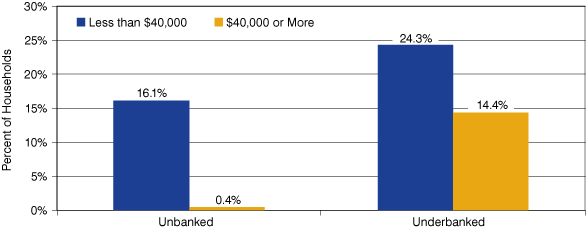
Source: IBRC, using data from the U.S. Census Bureau Current Population Survey (CPS)
Jointly considering race and income status, we see that minority households in Indiana are still more likely to be unbanked or underbanked than white households even when we account for differences in income (see Figure 4). For households earning less than $40,000, roughly the same proportion of minority (28.1 percent) and white (23.3 percent) households are underbanked, but 36.1 percent of minority households are unbanked compared to only 10.5 percent of similar white households.
Among households earning $40,000 or more, there are still almost 5 percent of minority households that are unbanked while all white households in this income group report having a checking or savings account. More surprising is that over a third of higher-income minority households still rely on the use of non-bank financial services while only 12.6 percent of similar white households do.
Figure 4: Unbanked and Underbanked Households in Indiana by Household Income and Race/Ethnicity
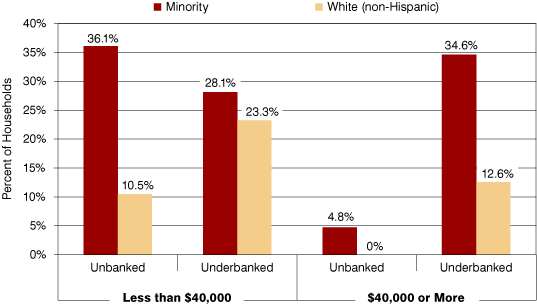
Source: IBRC, using data from the U.S. Census Bureau Current Population Survey (CPS)
Unbanked and Underbanked across Indiana’s Metropolitan Areas
While the overall percentage of unbanked and underbanked households in Indiana is 24.1 percent, there were differences in the metropolitan statistical areas (MSAs) across the state (see Figure 5).5 Notably, Fort Wayne had the lowest concentration of households lacking financial services from traditional banking institutions at 13.4 percent, well below the statewide percentage of 24.1 percent. On the other extreme are three MSAs—Bloomington, Cincinnati-Middletown and Evansville in which over a third of households were either unbanked or underbanked.
Figure 5: Unbanked/Underbanked as a Percent of All Households for Selected MSAs
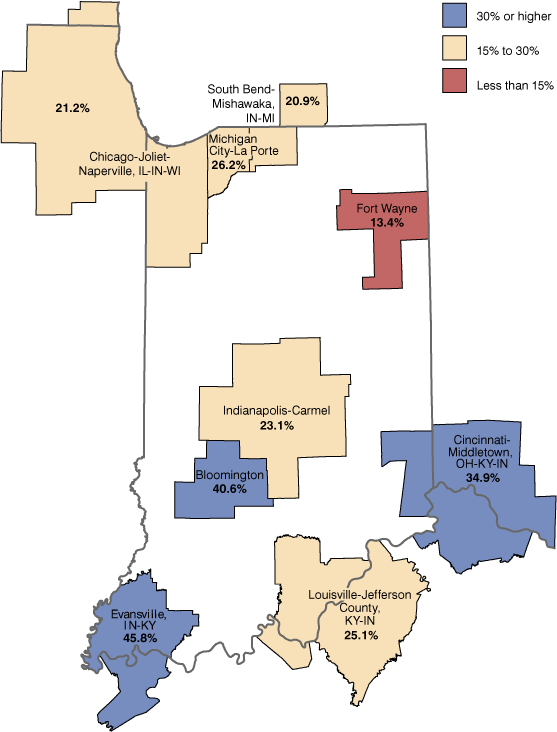
Source: IBRC, using data from the U.S. Census Bureau Current Population Survey (CPS)
The sample size was large enough in the Indianapolis-Carmel MSA to allow a closer inspection of the data. There are fewer underbanked households (12.5 percent) in this region compared to the state average (16.8 percent), but the percentage of unbanked households in the MSA (10.5 percent) is slightly higher than the state average (7.4 percent).
Figure 6 shows particularly large differences within the unbanked population when we consider race/ethnicity and income level in the Indianapolis-Carmel MSA. Looking at just those households earning less than $40,000 in the region, 45.8 percent of minority households were unbanked compared to 15.7 percent of white households.
Since an additional 21.4 percent of lower-income minority households are underbanked, these results illustrate that over two-thirds of these households in the Indianapolis-Carmel MSA rely partly or fully on non-bank institutions for their financial needs. Interestingly, even 31 percent of minority households that earn $40,000 or more are underbanked—indicating that they still rely on alternative financial service providers even though they do have bank accounts.
Figure 6: Unbanked and Underbanked Households in the Indianapolis-Carmel MSA by Household Income and Race/Ethnicity
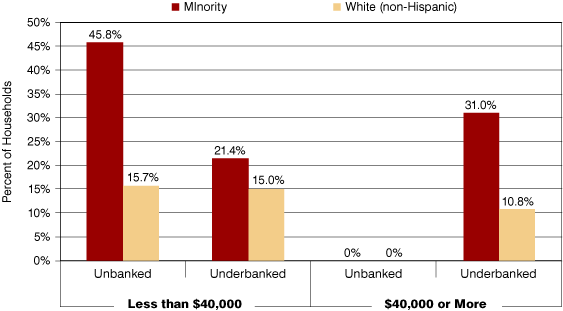
Source: IBRC, using data from the U.S. Census Bureau Current Population Survey (CPS)
Importance of Access to Banking Services
The number of households lacking bank accounts and the widespread use of institutions other than banks or credit unions for services such as check cashing and money orders is troubling to economic developers. Economists such as Sherrie Rhine and colleagues argue that broader participation in mainstream financial markets can rejuvenate communities and make them more resilient against economic downturns and better able to take advantage of economic growth. At an individual level, banking can also facilitate asset building and wealth creation, which is key for retirement or coping with unforeseen financial circumstances.6
The FDIC report finds that “the perceived convenience of [alternative financial services] providers and not having enough money to feel an account was needed” were key reasons cited by unbanked and underbanked households for their lack of full participation in the banking system. The fact that racial and ethnic minorities and lower income households are far more likely to be unbanked and underbanked suggests that substantial barriers exist and important measures are needed to ensure that these populations gain better access to secure financial services at banks and credit unions.
Notes
- More information about the survey methodology is available in the full FDIC report available at www.fdic.gov/householdsurvey/. For this study, CPS data were obtained through the National Bureau of Economic Research which maintains an extensive database of official federal data at www.nber.org/data/.
- Minority households have a male or female head of household who identified his or her race as all or partly black, Asian, American Indian/Alaskan Native, or Hawaiian/Pacific Islander or indicated Hispanic ethnicity. White households are headed by a man or a woman who indicated his/her race as “white only.”
- Details of the national survey are in the FDIC report.
- Calculations here are based on appendix tables of the FDIC report.
- Not all differences were statistically significant. Data were only available for 10 of the 16 MSAs that include Indiana residents, excluding Columbus, Elkhart-Goshen, Kokomo, Lafayette, Muncie and Terre Haute. Results for the Anderson MSA were also excluded due to a lack of statistically significant results.
- Sherrie L. W. Rhine, William H. Greene and Maude Toussaint-Comeau, “The Importance of Check-Cashing Businesses to the Unbanked: Racial/Ethnic Differences,” The Review of Economics and Statistics (2006).
Amia K. Foston
Economic Research Assistant, Indiana Business Research Center, Indiana University Kelley School of Business
Michael F. Thompson
Economic Research Analyst, Indiana Business Research Center, Indiana University Kelley School of Business
